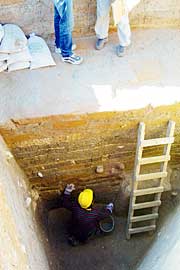A large building that was uncovered near the Ad Halum intersection was probably used by the kings of Assyria to thwart rebellion attempts in the area in the eighth century BC
Ran Shapira

The remains of the supposed wall. Building with square mud bricks is a Mesopotamian technique, which is not common in Israel. Photo: Dodo Becher
Direct link to this page: https://www.hayadan.org.il/ashdodfort1.html
The soldiers of Sargon II, king of Assyria, who conquered Ashdod in the eighth century BC, found a large and prosperous city that did not surrender easily to the foreign invader. Twice the kings of Ashdod rebelled against Assyrian rule. Following the attempted rebellion, the Assyrians built a massive structure near the city, probably a citadel, which allowed them to control what was happening there.
Last December, Elena Kogan Zahavi from the Antiquities Authority uncovered the remains of the citadel in an excavation she conducted near the railroad tracks near the industrial area at the Ad Halum junction, south of Ashdod. At the site, a few hundred meters north of Tel Ashdod, identified with ancient Ashdod, rectangular halls were found - the foundations of whose walls, about three meters thick, were built of square red bricks that were dried in the sun - and a large courtyard.
The citadel was built on a massive foundation. At the same time as the foundation, a part of a wall about 15 meters thick, also built of red square mud bricks, was also exposed. No remains of a floor were found near it, so it is likely that it was not part of a building but was used as a wall. Kogan-Zahavi estimates that the full length of the wall reaches tens of meters.
The style of construction and the shape of the bricks indicate the identity of the builders. Building with square mud bricks is a Mesopotamian technique, which is not common in Israel. A few years ago, the archaeologist Yossi Levy, in an excavation he did near Rishon Lezion, found square bricks. There, too, it was an Assyrian structure. At the site in Ashdod, several ritual vessels and pottery dating to the eighth century BC were also found.
Later changes were made to the citadel and it is possible that there was activity in it during the Babylonian occupation. The floors of the citadel were not preserved, due to late activity on the site, both of kilns for firing pottery from the Hellenistic period and of tomb buildings erected there in the Roman and Byzantine periods. However, the few remains that remain at the site from the days of Assyria's rule point to monumental construction, on a state scale, indicating the importance attributed to Ashdod at that time. Kogan Zahavi says that if the red brick wall was indeed used as a wall, it may have been part of the fortification of the city of Ashdod and in fact marked its true borders in the eighth century BC.
History connoisseur - ancient times
https://www.hayadan.org.il/BuildaGate4/general2/data_card.php?Cat=~~~751359829~~~158&SiteName=hayadan
